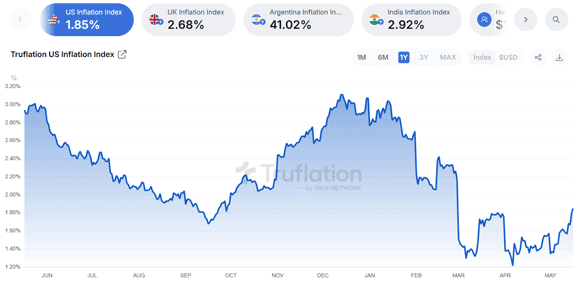
Federal Reserve Chairman Jerome Powell has been consistent about the central bank holding interest rates steady.
In his latest speech yesterday, he gave more details.
“We may be entering a period of more frequent, and potentially more persistent, supply shocks — a difficult challenge for the economy and for central banks,” noted JPow.
We’ve already seen the supply shocks, courtesy of President Trump – a daily change in tariff rates. Sometimes higher, sometimes lower. Sometimes on allies, sometimes on adversaries.
Although trade talks are underway and tariffs are waning, there certainly could be some more supply shocks ahead. But the danger seems significantly lower than a month ago.
In the meantime, we can’t help but notice a pattern. With falling inflation rates worldwide, the European Central Bank has been cutting interest rates. The Bank of England has been cutting interest rates.
Outside of the Bank of Japan, the odd man out is the Fed.
Truflation, the website that tracks thousands of prices nationwide in near real-time, shows that inflation has ticked up in recent weeks.

With a current read of under 1.9%, inflation may already be near the Fed’s target rate.
The Fed, obsessed with government statistics, many of which it compiles itself to justify the thousands of mainstream economists on staff, will be late to the party if it’s data-dependent on old methodologies.
The only real shock will come when Powell has to cut rates to gin up inflation numbers. And the look on Powell’s face when he has to throw a quarter into the “Trump was right” jar.
💸 From Sheik-y Relations to Petrodollar 2.0
Over the course of 4 days, President Trump secured some hefty investment commitments in the Middle East.
The United Arab Emirates has committed to investing $1.4 trillion in the U.S.
Saudi Arabia is good for $600 billion.
And Qatar? They’re throwing in $500 billion.
A little back-of-the-envelope math says that’s $2.5 trillion in investment capital. If that pile of money were an S&P 500 company, it would rank 4th in size.
Of course, these commitments will take place over several years.
But it’s a sign that the petro-dollar agreement of the 1970s, whereby oil money was recycled into U.S. Treasurys and backing the dollar itself, has shifted toward higher-growth opportunities. And not a moment too soon, given our research on how the petrodollar agreement is on its last legs.
🌍 Burry Shorts China – and High-Flying American Tech
13F filing season is here – a time when money managers have to disclose their holdings.
Michael Burry, who made billions shorting the housing market in 2008, and who got to be played by a relatively thin Christian Bale, has made the most notable moves.
He’s largely out of the market, having built up a considerable position of put options in Chinese tech stocks, and some of the Magnificent Seven stocks, such as Nvidia.
We’re not too surprised by that last move, as we’ve been noting since last year that the Mag 7 stocks carry a lofty valuation. Those stocks should see their valuation come down in time, although we think most investors should focus on better opportunities elsewhere rather than trying to nab a “Big Short” trade of their own.
On the international front, Burry first rushed into Chinese stocks in 2022, amid the bear market. China’s stock market has had a strong performance since, although that’s been fueled by the struggling country’s various stimulus measures.
On the long side? The only position Burry increased was in Estee Lauder, the cosmetics giant. Long cosmetics, short tech. As far as paired trades go, that’s a new one.
🧠 Checking In on UnitedHealth’s Health
Only 30 stocks make up the Dow Jones Industrial Average. So when one of them has seen their share price cut in half year-to-date, it’s notable.
Health insurance giant UnitedHealth can’t seem to catch a break. The company has been in the spotlight for the past six months, since the murder of one of its executives on the streets of Manhattan.
The company’s CEO unexpectedly resigned earlier this week, citing “personal reasons.” And they abandoned their financial guidance, citing rising medical care costs.
Yesterday shares took a further hit on a report that the Department of Justice is investigating the company for potential Medicare Fraud.
The report is surprising, although a few articles following the shooting of Brian Thompson also suggested he was under investigation for insider trading and fraud.
Shares hit a low under $250 yesterday and are already up to $280 in early trading – a 12% rally in less than 24 hours and a strong sign that the “buy the dip” mentality is alive and well.
It’s easy to see why.UNH’s drop to a relative strength index (RSI) of 9 is one of the most oversold single-stock reads you’ll ever see.

Our Grey Swan Investment Fraternity model portfolio is built around industry-leading companies and businesses that Addison describes as “nearly-perfect,” – reflecting the reality that there’s no such thing as the perfect stock.
A company with UnitedHealth’s level of management issues doesn’t currently fit into that model, even if it could see an oversold bounce higher from here.
With all the issues swirling around the company right now, the healthy thing for your portfolio is to find better opportunities, without the company-specific risk that UnitedHealth currently has.
~ Andrew
P.S. Thanks to our paid-up Fraternity members who joined Zoltan Istvan and me on Grey Swan Live! Yesterday.
The video is now available on the website. It was a fantastic conversation with Zoltan — covering everything from his latest run for governor of California, how the AI revolution could unfold, how quickly automation may make nearly all work obsolete, and why Zoltan has come around on assets like gold and crypto.



